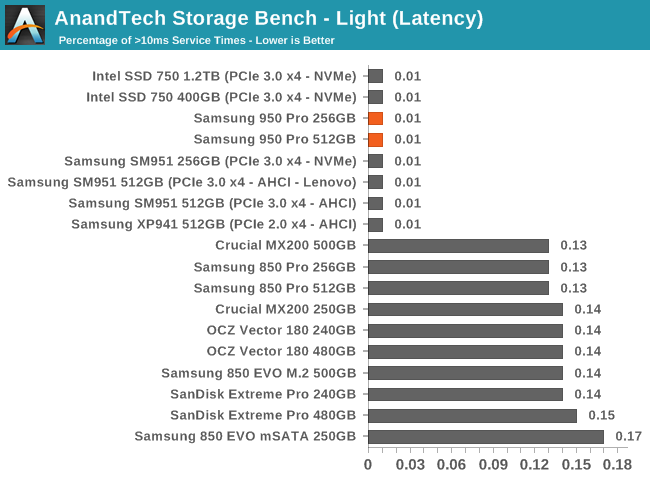The Samsung 950 Pro PCIe SSD Review (256GB and 512GB)
by Billy Tallis on October 22, 2015 10:55 AM ESTAnandTech Storage Bench - Light
Out Light storage test has relatively more sequential accesses and lower queue depths than The Destroyer or the Heavy test, and it's by far the shortest test overall. It's based largely on applications that aren't highly dependent on storage performance, so application launch times and file load times are what dominate this test. Details of the Light test can be found here.

The Light test starts to show a distinct advantage for NVMe, and the Samsung UBX controller is performing much better than Intel's SSD 750.

The three Samsung NVMe drives have the lowest average service time and the SATA drives are all looking quite slow by comparison.

The PCIe drives are all very good about keeping latency outliers to a minimum, but none have yet managed to complete the entire test without any request taking more than 10ms.

Despite stellar performance, the 950 Pro's power efficiency is poor. If our system could make use of some power management capabilities this situation could be very different, but for many consumers this is just the way things are for PCIe drives. The lack of power management support may be slightly helping some of the latency scores, as transitioning between power states usually requires a short interruption in service.










142 Comments
View All Comments
Gigaplex - Thursday, October 22, 2015 - link
It's unlikely Samsung is holding back, as the phenomenon is affecting all brands.ddriver - Monday, October 26, 2015 - link
Corporations do price fixing, why not performance fixing.niva - Wednesday, October 28, 2015 - link
It is possible to do performance fixing, but not likely in this case. Enterprise hardware should generally concentrate on endurance, probably using different binning and better memory. I'm sure they can beef up the drivers too and optimize for certain loads. In general they'll get the most sales by selling in greater numbers. Artificially limiting performance so they can make more profit margin on some (much smaller quantities) hardware being sold to enterprise doesn't make sense.That all being said I guess it is possible.
ShieTar - Monday, October 26, 2015 - link
Yes, there is a DRAM cache. The size of it is listed in the table on the first page of the article.Without this, random writes would still be horrible, as overwriting a complete 128KB block whenever the drive is supposed to write down just 4KB leads quickly to the need of reading, deleting & re-writing the blocks, as no unused 128KB-blocks are left.
Laststop311 - Tuesday, October 27, 2015 - link
its just part of how nand cells works. If you need faster speed 3d xpoint is coming to save the day.Per Hansson - Wednesday, October 28, 2015 - link
The DRAM cache is not used to cache writes.It's large size is mainly for the NAND mapping table.
If writes where cached in DRAM the performance of 4KB random writes would of course be waaay higher than what it is.
And quite extreme dataloss would occur in case of power loss.
virtualbigd - Wednesday, December 16, 2015 - link
Can you elaborate on your reliability point above, for Samsung?virtualbigd - Wednesday, December 16, 2015 - link
I know about 840 EVO, is there something else?Samus - Thursday, October 22, 2015 - link
I have my reservations over Samsung drives, especially since the 840 EVO, but DAMN.jay401 - Saturday, October 24, 2015 - link
Hey if you turn that V upside down, you have the first A-NAND SSD. :D